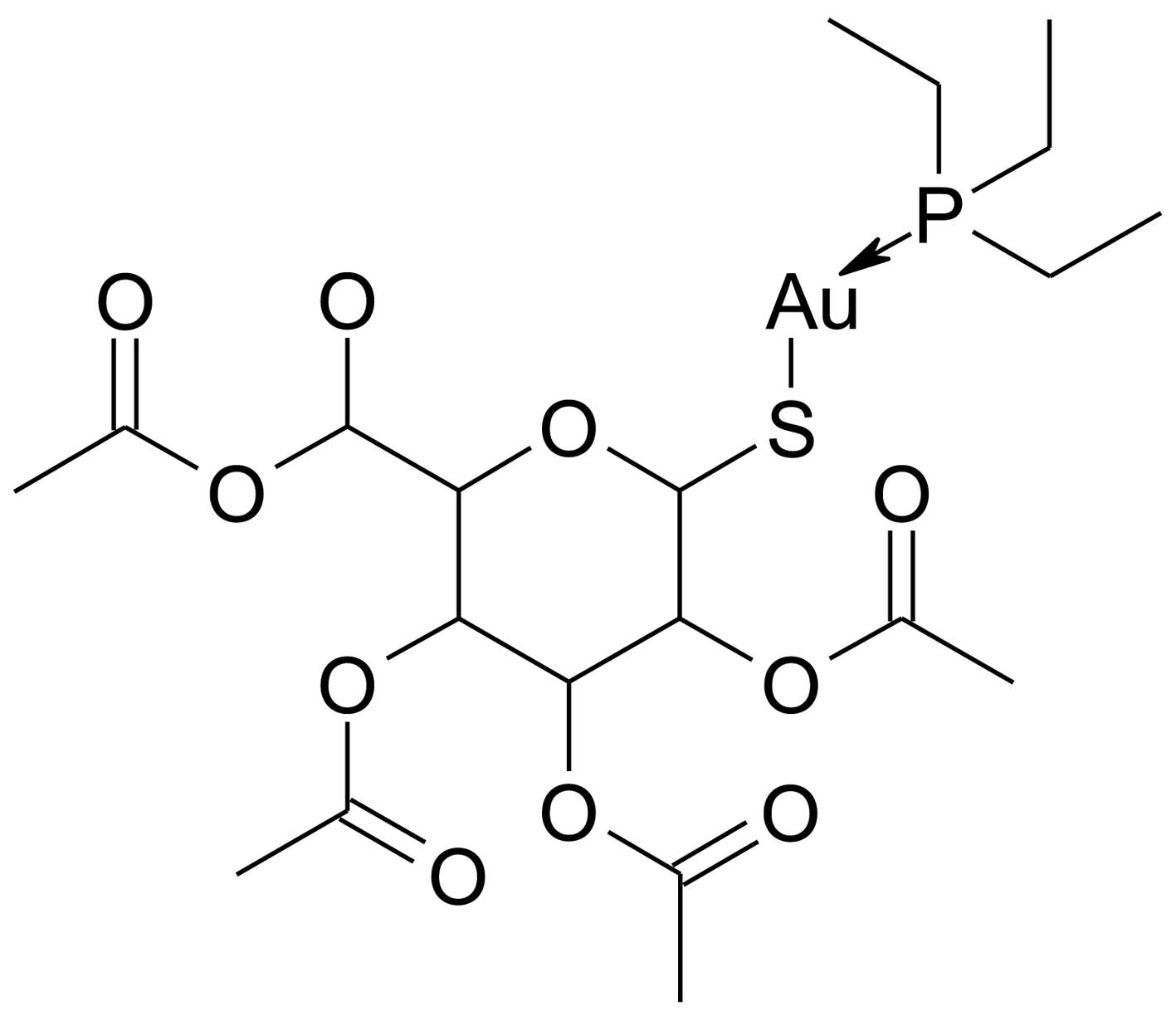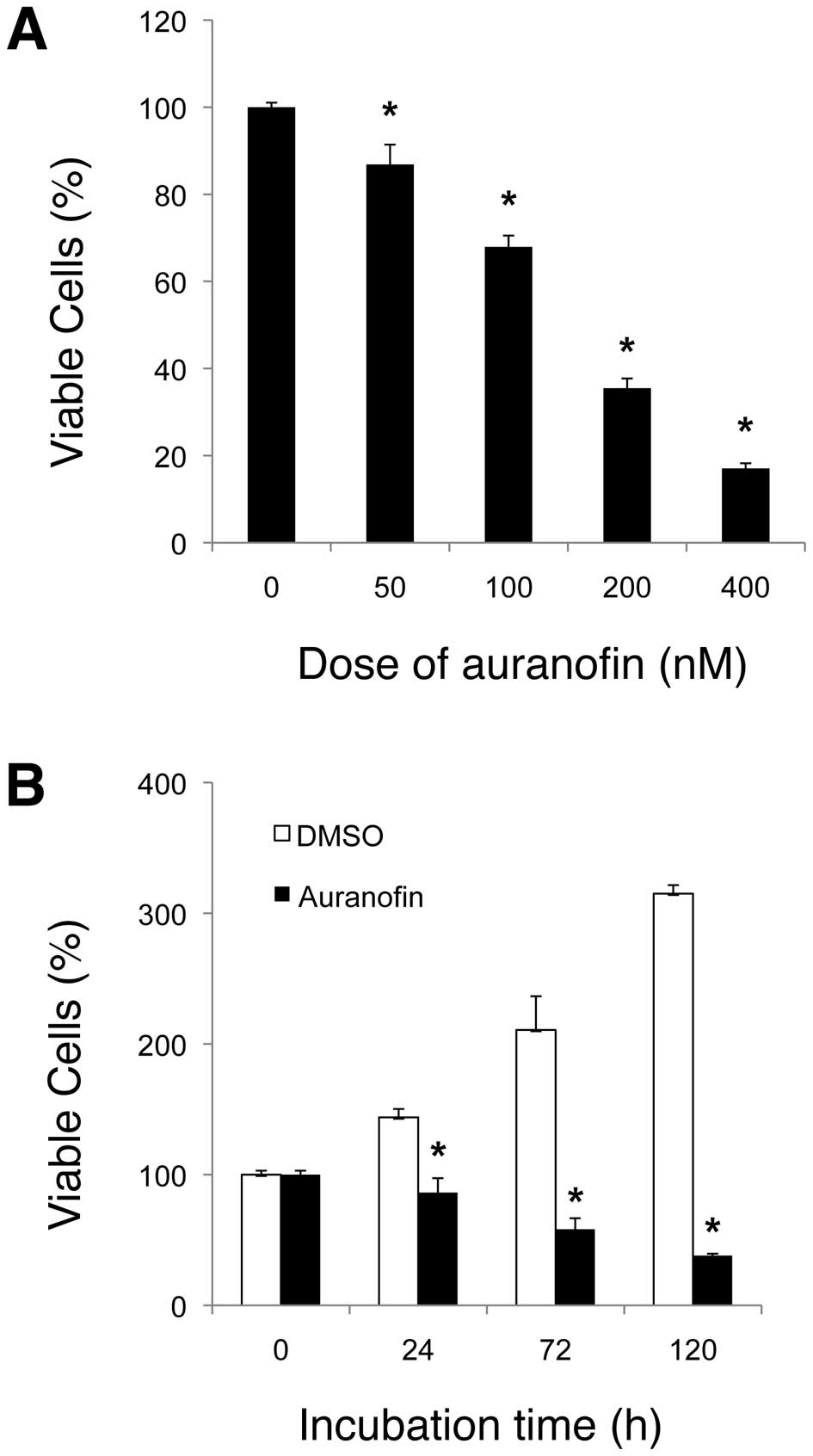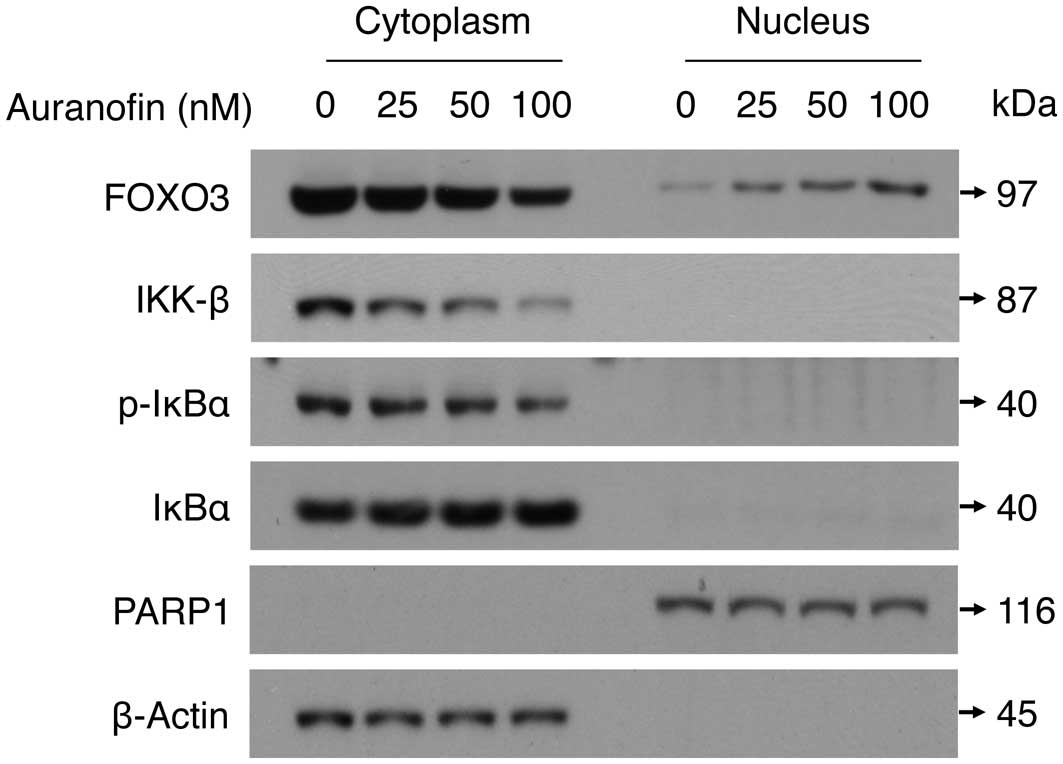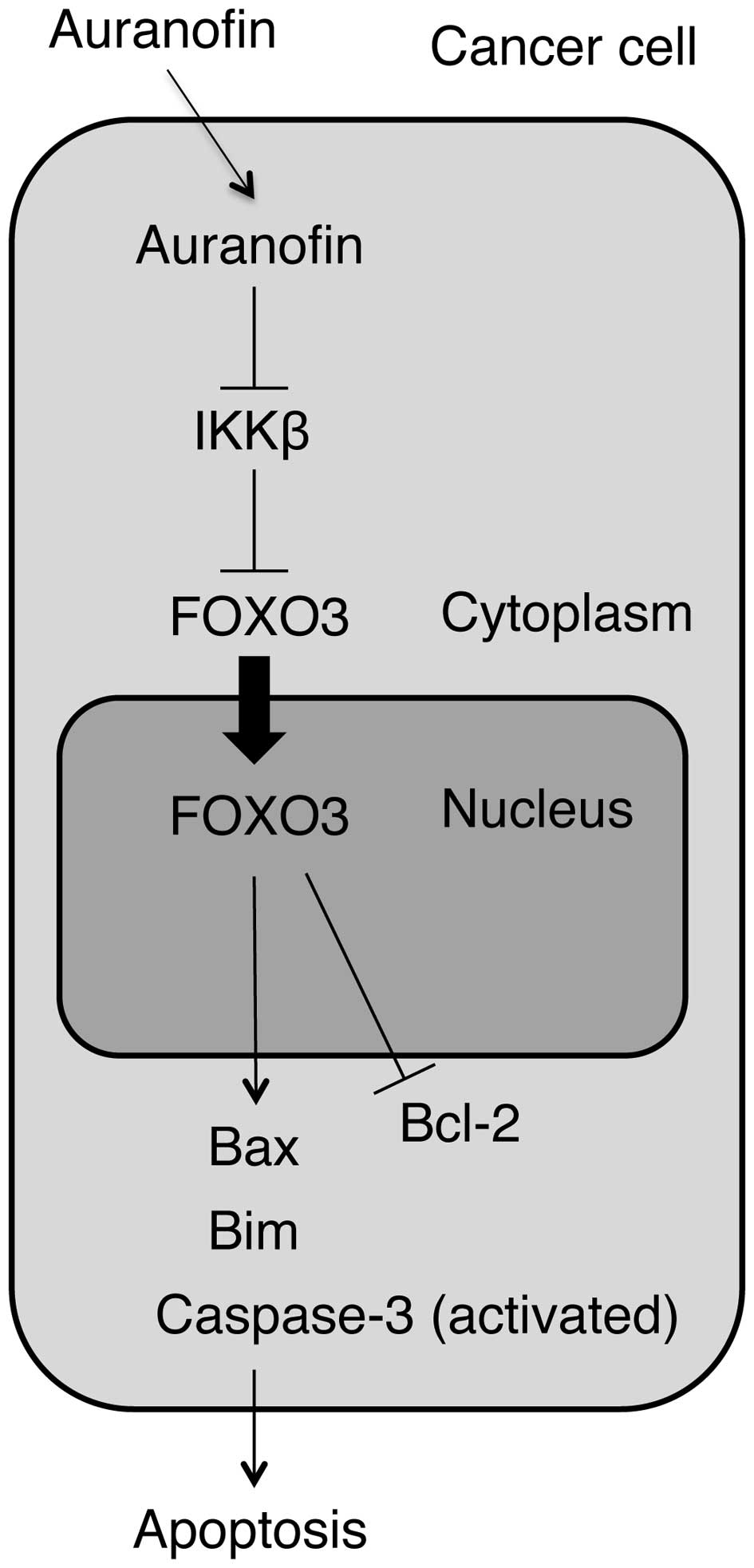|
1
|
Siegel R, Naishadham D and Jemal A: Cancer
statistics, 2012. CA Cancer J Clin. 62:10–29. 2012. View Article : Google Scholar
|
|
2
|
Banerjee S and Kaye SB: New strategies in
the treatment of ovarian cancer: current clinical perspectives and
future potential. Clin Cancer Res. 19:961–968. 2013. View Article : Google Scholar : PubMed/NCBI
|
|
3
|
Shigetomi H, Higashiura Y, Kajihara H and
Kobayashi H: Targeted molecular therapies for ovarian cancer: an
update and future perspectives. Oncol Rep. 28:395–408.
2012.PubMed/NCBI
|
|
4
|
Snyder RM, Mirabelli CK and Crooke SJ: The
cellular pharmacology of auranofin. Semin Arthritis Rheum.
17:71–80. 1987. View Article : Google Scholar : PubMed/NCBI
|
|
5
|
Madeira JM, Gibson DL, Kean WF and
Klegeris A: The biological activity of auranofin: implications for
novel treatment of diseases. Inflammopharmacology. 20:297–306.
2012. View Article : Google Scholar : PubMed/NCBI
|
|
6
|
Columbo M, Galeone D, Guidi G,
Kagey-Sobotka A, Lichtenstein LM, Pettit GR and Marone G:
Modulation of mediator release from human basophils and pulmonary
mast cells and macrophages by auranofin. Biochem Pharmacol.
39:285–2891. 1990. View Article : Google Scholar : PubMed/NCBI
|
|
7
|
Rigobello MP, Scutari G, Boscolo R and
Bindoli A: Induction of mitochondrial permeability transition by
auranofin, a gold(I)-phosphine derivative. Br J Pharmacol.
136:1162–1168. 2002. View Article : Google Scholar : PubMed/NCBI
|
|
8
|
Jeon KI, Jeong JY and Jue DM:
Thiol-reactive metal compounds inhibit NF-κB activation by blocking
IκB kinase. J Immunol. 164:5981–5989. 2000.PubMed/NCBI
|
|
9
|
Kim IS, Jin JY, Lee IH and Park SJ:
Auranofin induces apoptosis and when combined with retinoid acid
enhances differentiation of acute promyelocytic leukaemia cells in
vitro. Br J Pharmacol. 142:749–755. 2004. View Article : Google Scholar : PubMed/NCBI
|
|
10
|
Park SJ and Kim IS: The role of p38 MAPK
activation for auranofin-induced apoptosis of human promyelocytic
leukaemia HL-60 cells. Br J Pharmacol. 146:506–513. 2005.
View Article : Google Scholar : PubMed/NCBI
|
|
11
|
Tsai WB, Chung YM, Zou Y, Park SH, Xu Z,
Nakayama K, Lin SH and Hu MC: Inhibition of FOXO3 tumor suppressor
function by βTrCP1 through ubiquitin-mediated degradation in a
tumor mouse model. PLoS One. 5:e111712010.
|
|
12
|
Hu MC, Lee DF, Xia W, Golfman LS, Ou-Yang
F, Yang JY, Zou Y, Bao S, Hanada N, Saso H, Kobayashi R and Hung
MC: IkappaB kinase promotes tumorigenesis through inhibition of
forkhead FOXO3a. Cell. 117:225–237. 2004. View Article : Google Scholar : PubMed/NCBI
|
|
13
|
Katoh M and Katoh M: Human FOX gene
family. Int J Oncol. 25:1495–1500. 2004.PubMed/NCBI
|
|
14
|
Alvarez B, Martinez AC, Burgering BM and
Carrera AC: Forkhead transcription factors contribute to execution
of the mitotic programme in mammals. Nature. 413:744–747. 2001.
View Article : Google Scholar : PubMed/NCBI
|
|
15
|
Furukawa-Hibi Y, Kobayashi Y, Chen C and
Motoyama N: FOXO transcription factors in cell-cycle regulation and
the response to oxidative stress. Antioxid Redox Signal. 7:752–760.
2005. View Article : Google Scholar : PubMed/NCBI
|
|
16
|
Brunet A, Bonni A, Zigmond MJ, Lin MZ, Juo
P, Hu LS, Anderson MJ, Arden KC, Blenis J and Greenberg ME: Akt
promotes cell survival by phosphorylating and inhibiting a Forkhead
transcription factor. Cell. 96:857–868. 1999. View Article : Google Scholar : PubMed/NCBI
|
|
17
|
Sunters A, Fernández de Mattos S, Stahl M,
Brosens JJ, Zoumpoulidou G, Saunders CA, Coffer PJ, Medema RH,
Coombes RC and Lam EW: FOXO3 transcriptional regulation of Bim
controls apoptosis in paclitaxel-treated breast cancer cell lines.
J Biol Chem. 278:49795–49805. 2003. View Article : Google Scholar : PubMed/NCBI
|
|
18
|
Fu Z and Tindall DJ: FOXOs, cancer and
regulation of apoptosis. Oncogene. 27:2312–2319. 2008. View Article : Google Scholar : PubMed/NCBI
|
|
19
|
Chung YM, Park SH, Tsai WB, Wang SY, Ikeda
MA, Berek JS, Chen DJ and Hu MC: FOXO3 signalling links ATM to the
p53 apoptotic pathway following DNA damage. Nat Commun. 3:10002012.
View Article : Google Scholar : PubMed/NCBI
|
|
20
|
Tran H, Brunet A, Grenier JM, Datta SR,
Fornace AJ Jr, DiStefano PS, Chiang LW and Greenberg ME: DNA repair
pathway stimulated by the forkhead transcription factor FOXO3a
through the Gadd45 protein. Science. 296:530–534. 2002. View Article : Google Scholar : PubMed/NCBI
|
|
21
|
Tsai WB, Chung YM, Takahashi Y, Xu Z and
Hu MC: Functional interaction between FOXO3 and ATM regulates DNA
damage response. Nat Cell Biol. 10:460–467. 2008. View Article : Google Scholar : PubMed/NCBI
|
|
22
|
Yang J-Y, Xia W and Hu MC: Induction of
FOXO3a and Bim expression in response to ionizing radiation. Int J
Oncol. 29:643–648. 2006.PubMed/NCBI
|
|
23
|
Sunters A, Madureira PA, Pomeranz KM,
Aubert M, Brosens JJ, Cook SJ, Burgering BM, Coombes RC and Lam EW:
Paclitaxel-induced nuclear translocation of FOXO3 in breast cancer
cells is mediated by c-Jun NH2-terminal kinase and Akt. Cancer Res.
66:212–220. 2006. View Article : Google Scholar : PubMed/NCBI
|
|
24
|
Nemoto S, Fergusson MM and Finkel T:
Nutrient availability regulates SIRT1 through a forkhead-dependent
pathway. Science. 306:2105–2108. 2004. View Article : Google Scholar : PubMed/NCBI
|
|
25
|
Greer EL and Brunet A: FOXO transcription
factors at the interface between longevity and tumor suppression.
Oncogene. 24:7410–7425. 2005. View Article : Google Scholar : PubMed/NCBI
|
|
26
|
Seoane J, Le HV, Shen L, Anderson SA and
Massagué J: Integration of Smad and forkhead pathways in the
control of neuroepithelial and glioblastoma cell proliferation.
Cell. 117:211–223. 2004. View Article : Google Scholar : PubMed/NCBI
|
|
27
|
Paik JH, Kollipara R, Chu G, Ji H, Xiao Y,
Ding Z, Miao L, Tothova Z, Horner JW, Carrasco DR, Jiang S,
Gilliland DG, Chin L, Wong WH, Castrillon DH and DePinho RA: FoxOs
are lineage-restricted redundant tumor suppressors and regulate
endothelial cell homeostasis. Cell. 128:309–323. 2007. View Article : Google Scholar : PubMed/NCBI
|
|
28
|
Miyamoto K, Araki KY, Naka K, Arai F,
Takubo K, Yamazaki S, Matsuoka S, Miyamoto T, Ito K, Ohmura M, Chen
C, Hosokawa K, Nakauchi H, Nakayama K, Nakayama KI, Harada M,
Motoyama N, Suda T and Hirao A: FOXO3 is essential for maintenance
of the hematopoietic stem cell pool. Cell Stem Cell. 1:101–112.
2007. View Article : Google Scholar : PubMed/NCBI
|
|
29
|
Huang H and Tindall DJ: FOXO factors: a
matter of life and death. Future Oncol. 2:83–89. 2006. View Article : Google Scholar : PubMed/NCBI
|
|
30
|
Hu MC and Hung MC: Role of IkappaB kinase
in tumorigenesis. Future Oncol. 1:67–78. 2005. View Article : Google Scholar : PubMed/NCBI
|
|
31
|
Eijkelenboom A and Burgering BM: FOXOs:
signalling integrators for homeostasis maintenance. Nat Rev Mol
Cell Biol. 14:83–97. 2013. View
Article : Google Scholar : PubMed/NCBI
|
|
32
|
Lu M, Zhao Y, Xu F, Wang Y, Xiang J and
Chen D: The expression and prognosis of FOXO3a and Skp2 in human
ovarian cancer. Med Oncol. 29:3409–3915. 2012. View Article : Google Scholar : PubMed/NCBI
|
|
33
|
Fei M, Zhao Y, Wang Y, Lu M, Cheng C,
Huang X, Zhang D, Lu J, He S and Shen A: Low expression of Foxo3a
is associated with poor prognostic in ovarian cancer patients.
Cancer Invest. 27:52–59. 2009. View Article : Google Scholar : PubMed/NCBI
|
|
34
|
Habashy HO, Rakha EA, Aleskandarany M,
Ahmed MA, Green AR, Ellis IO and Powe DG: FOXO3a nuclear
localization is associated with good prognosis in luminal-like
breast cancer. Breast Cancer Res Treat. 129:11–21. 2011. View Article : Google Scholar : PubMed/NCBI
|
|
35
|
Nicholson DW: Caspase structure,
proteolytic substrates, and function during apoptotic cell death.
Cell Death Differ. 6:1028–1042. 1999. View Article : Google Scholar : PubMed/NCBI
|
|
36
|
Lazebnik YA, Kaufmann SH, Desnoyers S,
Poirier GG and Earnshaw WC: Cleavage of poly(ADP-ribose) polymerase
by a proteinase with properties like ICE. Nature. 371:346–347.
1994. View
Article : Google Scholar : PubMed/NCBI
|
|
37
|
Kumari SR, Mendoza-Alvarez H and
Alvarez-Gonzalez R: Functional interactions of p53 with
poly(ADP-ribose) polymerase (PARP) during apoptosis following DNA
damage: covalent poly(ADP-ribosyl)ation of p53 by exogenous PARP
and noncovalent binding of p53 to the M(r) 85,000 proteolytic
fragment. Cancer Res. 58:5075–5078. 1998.
|
|
38
|
Carvajal LA and Manfredi JJ: Another fork
in the road - life or death decisions by the tumour suppressor p53.
EMBO Rep. 14:414–421. 2013. View Article : Google Scholar : PubMed/NCBI
|
|
39
|
Yoshida K and Miki Y: The cell death
machinery governed by the p53 tumor suppressor in response to DNA
damage. Cancer Sci. 101:831–835. 2010. View Article : Google Scholar : PubMed/NCBI
|
|
40
|
Das S, Boswell SA, Aaronson SA and Lee SW:
P53 promoter selection: choosing between life and death. Cell
Cycle. 7:154–157. 2008. View Article : Google Scholar : PubMed/NCBI
|
|
41
|
Fung-Kee-Fung M, Oliver T, Elit L, Oza A,
Hirte HW and Bryson P: Optimal chemotherapy treatment for women
with recurrent ovarian cancer. Curr Oncol. 14:195–208. 2007.
View Article : Google Scholar : PubMed/NCBI
|
|
42
|
Chong CR and Sullivan DJ Jr: New uses for
old drugs. Nature. 448:645–646. 2007. View Article : Google Scholar : PubMed/NCBI
|


















